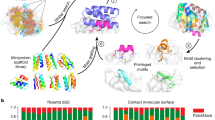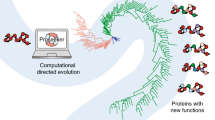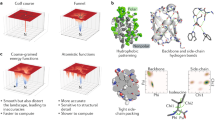Abstract
We developed a 'computational second-site suppressor' strategy to redesign specificity at a protein-protein interface and applied it to create new specifically interacting DNase-inhibitor protein pairs. We demonstrate that the designed switch in specificity holds in in vitro binding and functional assays. We also show that the designed interfaces are specific in the natural functional context in living cells, and present the first high-resolution X-ray crystallographic analysis of a computer-redesigned functional protein-protein interface with altered specificity. The approach should be applicable to the design of interacting protein pairs with novel specificities for delineating and re-engineering protein interaction networks in living cells.
This is a preview of subscription content, access via your institution
Access options
Subscribe to this journal
Receive 12 print issues and online access
$189.00 per year
only $15.75 per issue
Buy this article
- Purchase on Springer Link
- Instant access to full article PDF
Prices may be subject to local taxes which are calculated during checkout






Similar content being viewed by others
References
Bogan, A.A. & Thorn, K.S. Anatomy of hot spots in protein interfaces. J. Mol. Biol. 280, 1–9 (1998).
Conte, L.L., Chothia, C. & Janin, J. The atomic structure of protein-protein recognition sites. J. Mol. Biol. 285, 2177–2198 (1999).
Sharp, K.A. Calculation of HyHel10-lysozyme binding free energy changes: effect of ten point mutations. Proteins 33, 39–48 (1998).
Massova, I. & Kollman, P.A. Computational alanine scanning to probe protein-protein interactions: a novel approach to evaluate binding free energies. J. Am. Chem. Soc. 121, 8133–8143 (1999).
Huo, S., Massova, I. & Kollman, P.A. Computational alanine scanning of the 1:1 human growth hormone-receptor complex. J. Comput. Chem. 23, 15–27 (2002).
Guerois, R., Nielsen, J.E. & Serrano, L. Predicting changes in the stability of proteins and protein complexes: a study of more than 1000 mutations. J. Mol. Biol. 320, 369–387 (2002).
Kortemme, T. & Baker, D. A simple physical model for binding energy hot spots in protein-protein complexes. Proc. Natl. Acad. Sci. USA 99, 14116–14121 (2002).
Brannetti, B., Via, A., Cestra, G., Cesareni, G. & Helmer-Citterich, M. SH3-SPOT: an algorithm to predict preferred ligands to different members of the SH3 gene family. J. Mol. Biol. 298, 313–328 (2000).
Vaccaro, P. et al. Distinct binding specificity of the multiple PDZ domains of INADL, a human protein with homology to INAD from Drosophila melanogaster. J. Biol. Chem. 276, 42122–42130 (2001).
Li, L., Shakhnovich, E.I. & Mirny, L.A. Amino acids determining enzyme-substrate specificity in prokaryotic and eukaryotic protein kinases. Proc. Natl. Acad. Sci. USA 100, 4463–4468 (2003).
Aloy, P. & Russell, R.B. Interrogating protein interaction networks through structural biology. Proc. Natl. Acad. Sci. USA 99, 5896–5901 (2002).
Wollacott, A.M. & Desjarlais, J.R. Virtual interaction profiles of proteins. J. Mol. Biol. 313, 317–342 (2001).
Desjarlais, J.R. & Handel, T.M. De novo design of the hydrophobic cores of proteins. Protein Sci. 4, 2006–2018 (1995).
Ventura, S. et al. Conformational strain in the hydrophobic core and its implications for protein folding and design. Nat. Struct. Biol. 9, 485–493 (2002).
Bolon, D.N., Marcus, J.S., Ross, S.A. & Mayo, S.L. Prudent modeling of core polar residues in computational protein design. J. Mol. Biol. 329, 611–622 (2003).
Pokala, N. & Handel, T.M. Review: protein design—where we were, where we are, where we're going. J. Struct. Biol. 134, 269–281 (2001).
Hellinga, H.W., Caradonna, J.P. & Richards, F.M. Construction of new ligand binding sites in proteins of known structure. II. Grafting of a buried transition metal binding site into Escherichia coli thioredoxin. J. Mol. Biol. 222, 787–803 (1991).
Dahiyat, B.I. & Mayo, S.L. De novo protein design: fully automated sequence selection. Science 278, 82–87 (1997).
Nauli, S., Kuhlman, B. & Baker, D. Computer-based redesign of a protein folding pathway. Nat. Struct. Biol. 8, 602–605 (2001).
Harbury, P.B., Plecs, J.J., Tidor, B., Alber, T. & Kim, P.S. High-resolution protein design with backbone freedom. Science 282, 1462–1467 (1998).
Kuhlman, B. et al. Design of a novel globular protein fold with atomic level accuracy. Science 302, 1364–1368 (2003).
Looger, L.L., Dwyer, M.A., Smith, J.J. & Hellinga, H.W. Computational design of receptor and sensor proteins with novel functions. Nature 423, 185–190 (2003).
Harbury, P.B., Zhang, T., Kim, P.S. & Alber, T. A switch between two-, three-, and four-stranded coiled coils in GCN4 leucine zipper mutants. Science 262, 1401–1407 (1993).
Havranek, J.J. & Harbury, P.B. Automated design of specificity in molecular recognition. Nat. Struct. Biol. 10, 45–52 (2003).
Shifman, J.M. & Mayo, S.L. Modulating calmodulin binding specificity through computational protein design. J. Mol. Biol. 323, 417–423 (2002).
Reina, J. et al. Computer-aided design of a PDZ domain to recognize new target sequences. Nat. Struct. Biol. 9, 621–627 (2002).
Shifman, J.M. & Mayo, S.L. Exploring the origins of binding specificity through the computational redesign of calmodulin. Proc. Natl. Acad. Sci. USA 100, 13274–13279 (2003).
Ko, T.P., Liao, C.C., Ku, W.Y., Chak, K.F. & Yuan, H.S. The crystal structure of the DNase domain of colicin E7 in complex with its inhibitor Im7 protein. Structure Fold. Des. 7, 91–102 (1999).
Schamberger, G.P. & Diez-Gonzalez, F. Selection of recently isolated colicinogenic Escherichia coli strains inhibitory to Escherichia coli O157:H7. J. Food. Prot. 65, 1381–1387 (2002).
Murinda, S.E., Rashid, K.A. & Roberts, R.F. In vitro assessment of the cytotoxicity of nisin, pediocin, and selected colicins on simian virus 40-transfected human colon and Vero monkey kidney cells with trypan blue staining viability assays. J. Food. Prot. 66, 847–853 (2003).
Kuhlman, B. & Baker, D. Native protein sequences are close to optimal for their structures. Proc. Natl. Acad. Sci. USA 97, 10383–10388 (2000).
Kortemme, T., Morozov, A.V. & Baker, D. An orientation-dependent hydrogen bonding potential improves prediction of specificity and structure for proteins and protein-protein complexes. J. Mol. Biol. 326, 1239–1259 (2003).
Morozov, A.V., Kortemme, T. & Baker, D. Evaluation of models of electrostatic interactions in proteins. J. Phys. Chem. B 107, 2075–2090 (2003).
Wallis, R. et al. Protein-protein interactions in colicin E9 DNase-immunity protein complexes. 2. Cognate and noncognate interactions that span the millimolar to femtomolar affinity range. Biochemistry 34, 13751–13759 (1995).
Kleanthous, C., Hemmings, A.M., Moore, G.R. & James, R. Immunity proteins and their specificity for endonuclease colicins: telling right from wrong in protein-protein recognition. Mol. Microbiol. 28, 227–233 (1998).
Kuhlmann, U.C., Pommer, A.J., Moore, G.R., James, R. & Kleanthous, C. Specificity in protein-protein interactions: the structural basis for dual recognition in endonuclease colicin–immunity protein complexes. J. Mol. Biol. 301, 1163–1178 (2000).
Covell, D.G. & Wallqvist, A. Analysis of protein-protein interactions and the effects of amino acid mutations on their energetics. The importance of water molecules in the binding epitope. J. Mol. Biol. 269, 281–297 (1997).
Dunbrack, R.L., Jr. & Cohen, F.E. Bayesian statistical analysis of protein side-chain rotamer preferences. Protein Sci. 6, 1661–1681 (1997).
Lazaridis, T. & Karplus, M. Effective energy function for proteins in solution. Proteins 35, 133–152 (1999).
Otwinowski, J. & Minor, W. Processing of X-ray data collected in oscillation mode. Methods Enzymol. 276, 307–326 (1997).
Kissinger, C.R., Gehlhaar, D.K. & Fogel, D.B. Rapid automated molecular replacement by evolutionary search. Acta Crystallogr. D 55, 484–491 (1999).
McRee, D.E. XtalView/Xfit—a versatile program for manipulating atomic coordinates and electron density. J. Struct. Biol. 125, 156–165 (1999).
Brunger, A.T. et al. Crystallography & NMR system: a new software suite for macromolecular structure determination. Acta Crystallogr. D 54, 905–921 (1998).
Acknowledgements
We thank the members of the Baker lab for stimulating discussions, and J. Havranek for critical reading of the manuscript. This work was supported by a long-term fellowship from the Human Frontier Science Program (T.K.), a Wellcome Trust International Prize fellowship (A.N.B.), a US National Institutes of Health (NIH) training grant (L.A.J.) and a grant from the NIH (D.B.).
Author information
Authors and Affiliations
Corresponding author
Ethics declarations
Competing interests
The authors declare no competing financial interests.
Rights and permissions
About this article
Cite this article
Kortemme, T., Joachimiak, L., Bullock, A. et al. Computational redesign of protein-protein interaction specificity. Nat Struct Mol Biol 11, 371–379 (2004). https://doi.org/10.1038/nsmb749
Received:
Accepted:
Published:
Issue Date:
DOI: https://doi.org/10.1038/nsmb749
This article is cited by
-
Structural design principles for specific ultra-high affinity interactions between colicins/pyocins and immunity proteins
Scientific Reports (2021)
-
Conceptual Constructive Models and Abstraction-as-Aggregation
Philosophia (2021)
-
Deciphering interaction fingerprints from protein molecular surfaces using geometric deep learning
Nature Methods (2020)
-
High-Throughput Generation of In Silico Derived Synthetic Antibodies via One-step Enzymatic DNA Assembly of Fragments
Molecular Biotechnology (2020)
-
A High-Throughput Platform for the Generation of Synthetic Ab Clones by Single-Strand Site-Directed Mutagenesis
Molecular Biotechnology (2019)



